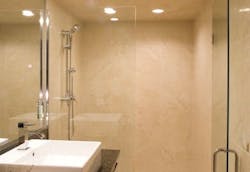Kitchen and bath design series: Tips on designing and specifying shower systems
What is the first thing that comes to mind when you think of a shower system? Is it the plumbing and mechanical side of the system, or is it a spa-style experience with multiple heads, steam, chromatherapy, and water falls? Both are correct. You can’t have beauty and functionality without first understanding the mechanics.
Today’s shower systems offer many options. First, there is a standard, single showerhead controlled by a pressure balance valve (PBV). You can add a hand shower using a shower arm diverter or wall diverter. You can also suggest a wall bar to adjust the height of the hand shower. This is particularly relevant for someone with special needs, be it height or handicap.
On the more luxurious side of things, you can go with up to two showerheads, but that would be the maximum with a PBV. Pressure balance valves are limited in the amount of water that they can handle — usually 5 gpm (gallons per minute). If you want to use more water, a thermostatic valve with volume control is required. Depending on the size of the therm valve and your water pressure, you can get up to 22 gpm.
There are a number of considerations when specifying thermostatic over PBV. Here are two major differences:
- PBVs only regulate pressure, not temperature. A thermostatic valve will regulate both. This means that as you use up your hot water with a PBV, the water coming out of the showerhead will keep getting cooler. For a five-minute shower with a single head, this is not a big deal. But once you add more showerheads, the water will cool much faster.
- A PBV starts from the off position and moves from cold to hot, always full force (no volume control). A thermostatic valve will only control the temperature and has no control over the water volume. You will need to add shuts offs, commonly referred to as volume controls. The more you use, the more you can customize the amount of water coming out and from which showerhead. Volume controls give you the ability to use more than one showerhead at a time. With a PBV, a diverter is required to switch between shower functions.
When it comes to designing custom showers, you are limited only by your imagination, as well as water supply to the home and plumbing codes. It’s great to dream big, and custom showers have never been more popular. For instance, even the iPod has made it into the shower, as have steam systems, speakers, and TVs. There are few limitations to what can go into today’s shower.
Some simple things to check when designing a custom shower:
- Make sure you will have enough hot water. Do you need to go with a bigger water heater?
- Do you have enough pressure? Is there enough water supply? It may be necessary to increase the pipe size going to the bathroom.
- Are there code restrictions to be considered? It is always a good idea to work with a decorative plumbing showroom in your area for the best information. They are usually the most up to date with local codes and have the most experience when it comes to designing plumbing systems for custom showers.
Some systems are easier to install than others. From the all-in-one, column-style showers to the multi-piece custom shower, most shower systems require a detailed drawing so that all trades involved understand what needs to be done. This is not limited to carpenters and plumbers, but tile, HVAC, and electrical trades.
Drainage should also be considered. The more water coming out at one time the larger the drain needed. I often recommend either two drains or the new trough-style drains. The trough drains provide more options when it comes to construction and tiling.
When deciding where to place the showerheads or water features, there are many factors to consider: The needs of the client, including where the spray will hit; Can the user turn the shower on without getting drenched?; Will the water go through the space between the door and the panel (or wall)?; Is there enough room for the plumber to plumb and the framer to frame? Proper design is crucial to making sure the finished product meets expectations.
Paul Greenspan has been working in the kitchen and bath industry for over 25 years. He has held local and national positions with the National Kitchen and Bath Association and the Bath and Kitchen Buying Group. He can be reached at [email protected].
